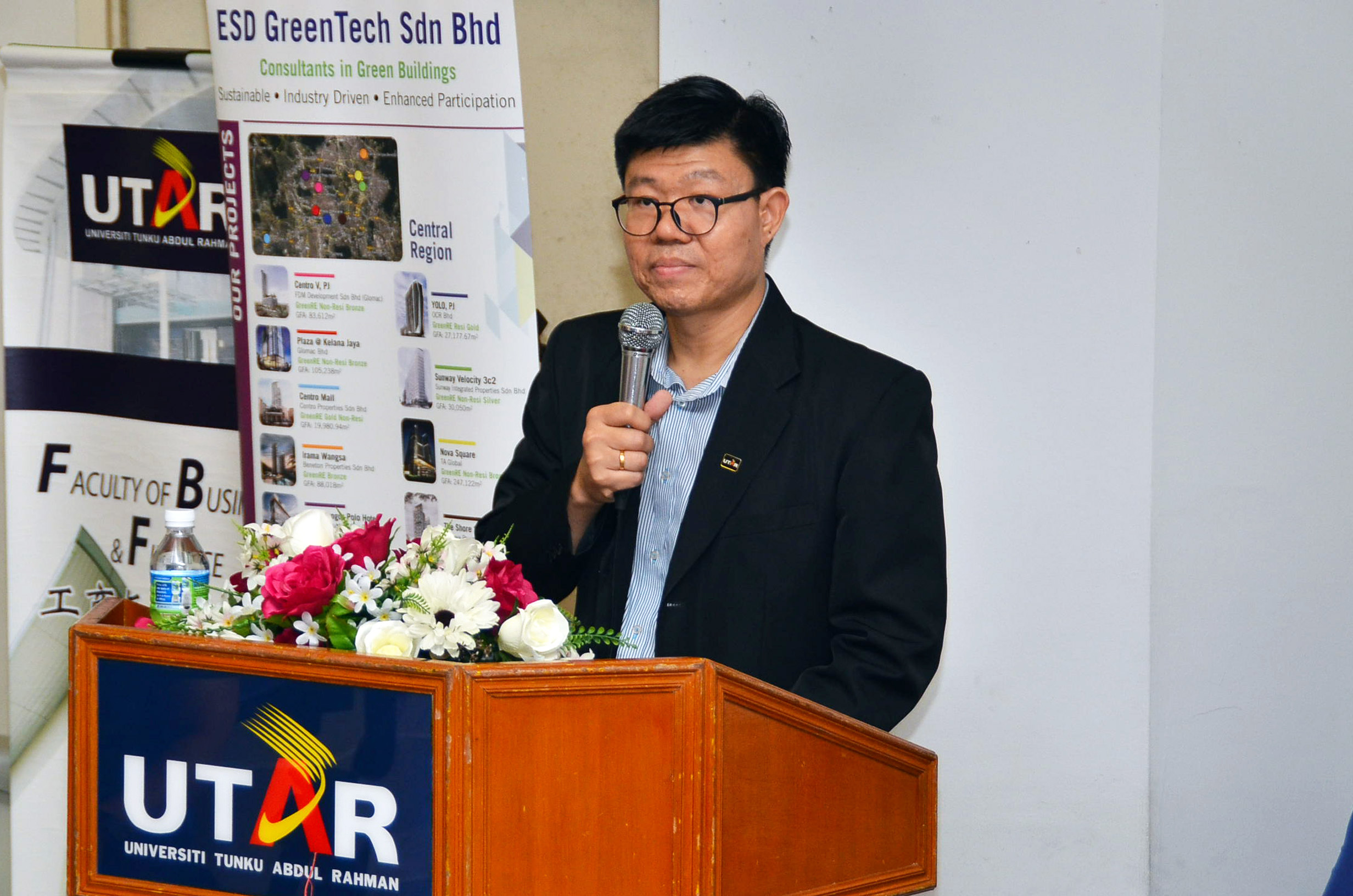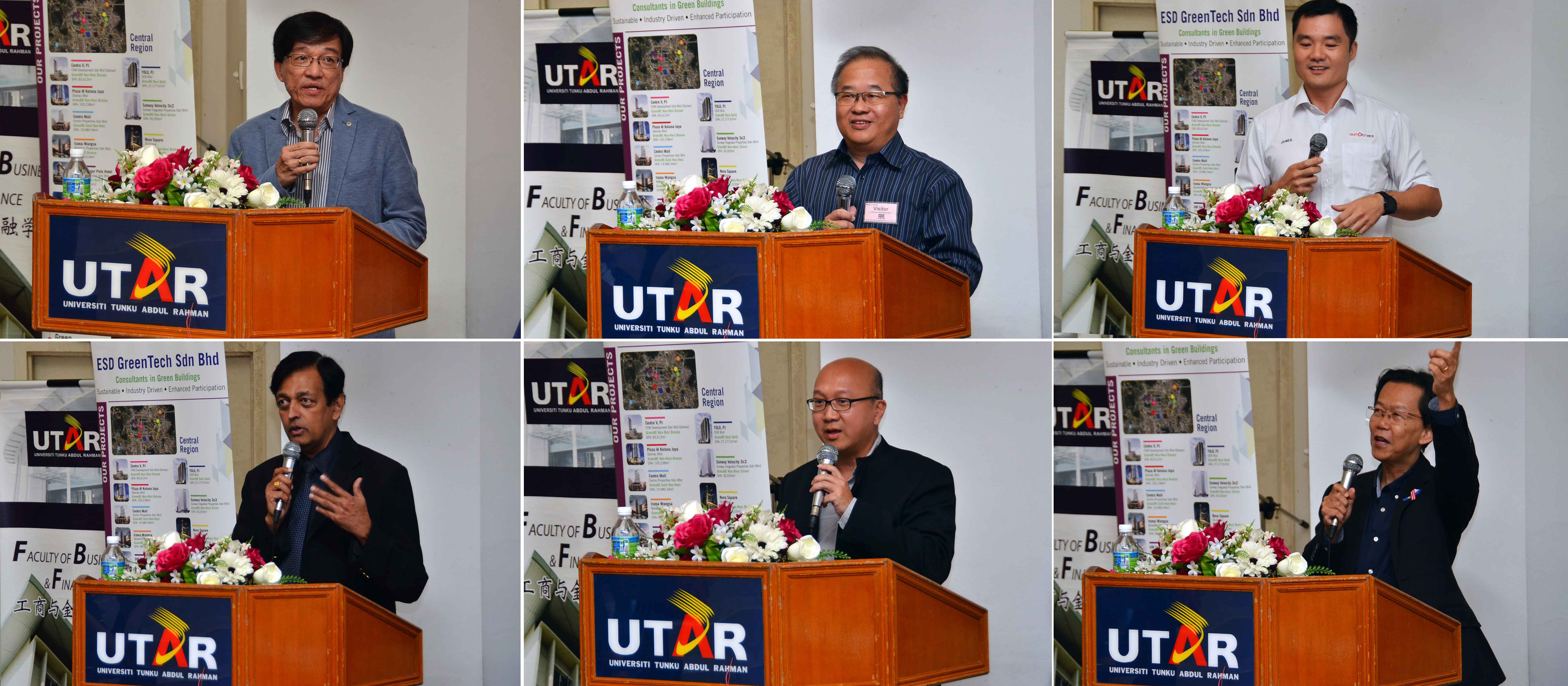


Front row, from left: Dr Au Yong, Prof Choong, Dr Foo, Dr Yew with participants
A real estate forum titled “Housing Market, Employment and Home Ownership: Current and Future” was co-organised by Centre for Economic Studies (CES) and Faculty of Business and Finance (FBF) on 20 June 2019 at UTAR Kampar Campus.
The invited speakers were Mah Sing Group Berhad CEO Datuk Ho Hon Sang, Beneton Properties Sdn Bhd Development Director Lee Yuk Chong, Suntrack Development Sdn Bhd CEO James Tan, Rabin & Associates Managing Partner Rabinder Singh, Arcadis (Malaysia) Sdn Bhd Executive Director Jeffrey Lim and ESD Greentech Sdn Bhd Consulting Director Ar Kevin Teh.
Present at the forum were Vice President for Student Development and Alumni Relations Prof Dr Choong Chee Keong, FBF Dean Dr Au Yong Hui Nee, CES Chairperson Dr Foo Chuan Chew and Organising Chairperson Dr Yiew Thian Hee.

Prof Choong welcoming the speakers
“At this very first property forum organised by the faculty, we are very privileged to learn from the real estate experts. It aimed to provide insights and valuable information from the various perspectives, namely from the developers’ (business), consumers’ and policymakers’ point of views. Therefore, I would like to thank the esteemed speakers for taking the time off their schedule to enlighten our students and staff,” said Prof Choong.

Top row, from left: Datuk Ho, Lee and Tan
Second row, from left: Rabinder, Lim and Teh
Datuk Ho enlightened participants with his presentation, titled “Real Estate: Past, Present, and Future”. He listed the characteristics of houses in the past and explained that old houses were predominantly made with timber plank wall. The brick walls were up to one-meter height from the ground. The roads in the old residential area were narrow and roadside drains were small which causes flooding during rainy season. With much development done over the years, Datuk Ho spoke about township development. He mentioned that it consisted of terrace houses, semi-detached, bungalow, shop houses, shop offices, light industrial factories, condominium, apartment and high-rise offices.
On the topic “Social and Affordable Housing”, Datuk Ho explained that it was driven by private developers through the imposition of stringent requirements by the Government. It involved various agencies, namely PRIMA, SPNB, PPA1M, JPN and SEDCs. However, he pointed out the occurrence of a mismatch of demand with supply due to the lack of coordination between location and infrastructure planning. He also cited low wages; salary growth not in tandem with the cost of living and house prices as the reasons for the low demands. Other obstacles for consumers to own houses included insufficient savings for down payment and loan ineligibility because of low credit worthiness. Though there are challenges for consumers and developers, he mentioned that the application of technology can be very helpful. Some of the technologies he listed were Big Data Analytics, artificial intelligence, internet of things (IoT), robotics, Smart Integrated Construction System, 3D Printing and smart city with IoT sensors.
Lee spoke about eco-friendly housing. He emphasised that eco-friendly houses are catered to the people and environment, benefitting the community and bringing positive impact for the environment. From a consumer perspective, Lee listed house design, lifestyle, status, properties standard, green features and sustainability as some of the elements that a consumer would consider when purchasing an eco-friendly house. Meanwhile for the environment, Lee explained that an eco-friendly house must be able to reduce pollutions, reduce energy consumption and for developers to develop public transport to reduce carbon footprint in residential areas.
The features of an eco-friendly house, as listed by Lee, included sustainable services, energy efficient facilities, rainwater harvesting, heat recovery system from the air conditioner, solar panel hot water heater, photovoltaic cell to harness electricity, cross ventilation, water efficient fittings, compost bins, natural lighting and green paint.
Tan, on the other hand, spoke on “Delivery Model of Social House”, and essential economic policy that affects consumers. He highlighted to the audience that there is no one-size-fits-all policy. That type of policy, as he explained, is not accurate and in fact, is damaging. He suggested that policymakers move away from such solutions. He suggested that policymakers should conduct housing need analysis as a viable solution for people to own social houses. He used examples from a few countries to demonstrate the effectiveness of their council home policy. The council homes are built for consumers to rent temporarily as they work to improve their financial capability to own an actual house. When the council home is vacant, the next temporary tenant is able to occupy that space while working or finding means to improve their financial capabilities. Tan explained that these council homes actually offer a sense of security by providing the community with accommodation, which is the very basic need for every human. Meanwhile, Rabinder spoke on the legal aspects of house ownership and provided participants with some legal advice.
Lim elucidated on “Competitive Housing Cost using Industrialised Building System (IBS)”. He enlightened participants with information about the construction industry in Malaysia. He talked about the easy access of labour force from neighbouring countries reduces the reliance on technological advancements. He also mentioned that structural works are still very labour intensive, with very large amount of wet works and in-situ finishing works at the site. Despite that, Lim mentioned that there is still a small number of players who utilises IBS. The reasons, according to Lim, were the lack of demands for lots with IBS components, no economy of scale due to large number of non-repetitive modules and the lack of government policies to encourage the use of IBS. Other factors for the lack of IBS also included limited design consultants who specialise in designing precast buildings, construction cost factor and site conditions.
Lim also listed some of the challenges faced in the evolving construction industry. He mentioned that the escalation of construction cost outscale the disposal income thus reducing the range of house citizen can afford to purchase. Another challenge faced is the lack of incentive to reduce construction cost by opting to standardise designs nationwide and the lack of incentive to promote the use of IBS. The third challenge he mentioned was the unavailability of a regulatory body or agency to provide a review on the contribution charges for an affordable home. The lack of increase in plot ratio for these affordable home schemes causes the land required for construction to decrease, which is also a challenge faced by the developers.
The last speaker Teh explained the benefits of green building. He explained that green building brings positive impacts to consumers, developers and the environment. The positive impacts of green buildings include reducing greenhouse gasses, in line with Sustainable Development Goals outlined by the United Nations, energy and water efficient and better waste management. Teh also mentioned that banks are supporting green building purchases by offering consumers a rebate or lower interest rate. Apart from enhancing the branding of developers, green building concept is proven to enhance health and productivity of staff, improve cognitive function and reduce allergies, asthma and respiratory problems.
The forum ended with an interactive Q&A session.
![]()
© 2019 UNIVERSITI TUNKU ABDUL RAHMAN DU012(A).
Wholly owned by UTAR Education Foundation Co. No. 578227-M LEGAL STATEMENT TERM OF USAGE PRIVACY NOTICE